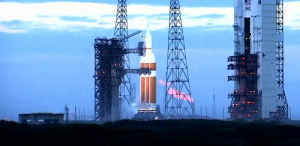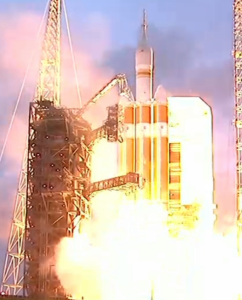On November 9, 1967, the most powerful rocket in human history, the Saturn V, roared to life for the first time on a mission to not only test the massive launch vehicle, but to also put the Apollo spacecraft through stress tests simulating the effects of atmospheric entry at the high velocities a craft would experience on the return trip from the moon. That test flight, known as Apollo 4, was a test that proved the capability of the entire moon vehicle, and after the disaster of Apollo 1, showed that we had the vehicle and system necessary to get humans to the moon.
Today, December 5th, 2014, a similar test flight occurred. This was the test flight of the Orion capsule, a vehicle designed to send humans back to the Moon and beyond. This mission was designed to stress test the Orion capsule in a way very reminiscent of Apollo 4, sending it further into space than any human-rated vehicle has gone since 1972, and putting it through re-entry tests at trans-lunar speeds the same way as the test 47 years ago.
The mission went flawlessly.
I’m not going to go over the mission details, or give an event by event breakdown; you can read that anywhere. I’m just going to give my thoughts on what this successful mission means to me as a space enthusiast.
This was one of those few events that could wake me up early, two days in a row. The original launch was scheduled for the morning of the 4th. I sat waiting the two and a half hours before they finally scrubbed the mission due to stuck valves on two of the core boosters. This came after a pair of holds due to excessive winds and a boat in the range. Needless to say, it was an irritating morning, and I went back to sleep upset, but looking forward to the launch the next morning, at the same time.
Indeed, that is what I did. Woke up before dawn my time to get ready to watch, and record, the launch. The countdown was flawless, with no holds called, no system errors, no random boats – nothing that could have held up the launch.I sat in my chair tense, watching the countdown. The most exciting moments of any rocket launch are the last 10 seconds, when the engines roar to life, stressing the hold down system of the launch pad as the vehicle begs to fly. I imagine no video or audio recordings can do justice to the raw power of some of these machines, but even sitting miles away in my room, I still feel the power of every launch. Every launch except this one. At about T-10 seconds, the video feed from NASA gave out, buffering for up to a minute, causing not only myself but probably thousands of others to miss the actual lift off. Thankfully, NASA showed replays of the launch after orbit was achieved, and I was able to record those views.
One view in particular caught my eye. I had noticed it yesterday morning, a view from the South at Launch Complex 20, looking North towards Launch Complex 37 and the Delta IV Heavy rocket. In between those two pads was a greyish abandoned structure, just in the bottom left of the camera field. I instantly recognized it as the ruins of Pad 34.
Pads 34 and 37 were originally built in the early 60’s for the Saturn rocket. Pads 34 and 37 saw all of the early Apollo test flights as well, as Apollo was pretty much built around the Saturn launch vehicle. Pad 34, however, saw on January 27th, 1967, the tragic Apollo 1 fire. Pad 34 had one more launch after that, Apollo 7, after which it was “abandoned in place” and after major superstructures were torn down, left as a monument to the memory of the Apollo 1 crew, the fire, and as a reminder of the risks associated with rushing in a field as dangerous as space travel. Pad 37 was used for a few other test flights before it too was abandoned. By the beginning of the 21st century, however, pad 37 had been converted into a launch facility for the Delta IV class of launch vehicle, including the Delta IV Heavy, the most powerful booster available currently to the United States. That was the booster that sent Orion on it’s historic flight this morning. There is something to be said about Pad 34 being visible in the launch footage of Orion. Orion is truly the spiritual grandchild of Apollo; it is our future in space and in this one flight has proven to be the most capable crewed spacecraft available. To see the remains of the launch pad where Apollo had it’s horrible start in frame with the first test flight of Orion was a powerful image to me. I honestly can’t put the feeling into words, which might explain the very all over the place style of this article. To see a human rated craft travel over 3000 Kilometers away from Earth, through the Van Allen radiation belts, and to see video feeds of Earth from that altitude, through the window of the spacecraft, is indescribable. I believe the future of the Human race is out in space, and it gives me hope for our survival to know that not only are we capable of such machines, but that we have the drive and curiosity to build such.
There is something to be said about Pad 34 being visible in the launch footage of Orion. Orion is truly the spiritual grandchild of Apollo; it is our future in space and in this one flight has proven to be the most capable crewed spacecraft available. To see the remains of the launch pad where Apollo had it’s horrible start in frame with the first test flight of Orion was a powerful image to me. I honestly can’t put the feeling into words, which might explain the very all over the place style of this article. To see a human rated craft travel over 3000 Kilometers away from Earth, through the Van Allen radiation belts, and to see video feeds of Earth from that altitude, through the window of the spacecraft, is indescribable. I believe the future of the Human race is out in space, and it gives me hope for our survival to know that not only are we capable of such machines, but that we have the drive and curiosity to build such.
I guess all that can be said is, if the biggest failure of the mission was the live stream failing just before liftoff, then we should all be incredibly proud of what Nasa has designed and the perfect performance of the United Launch Alliance Delta IV Heavy booster. As was said at liftoff, this was a launch at dawn, but also, the dawn or Orion.

